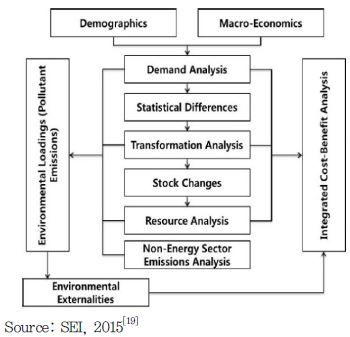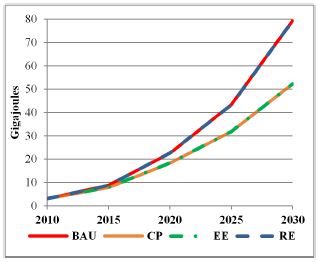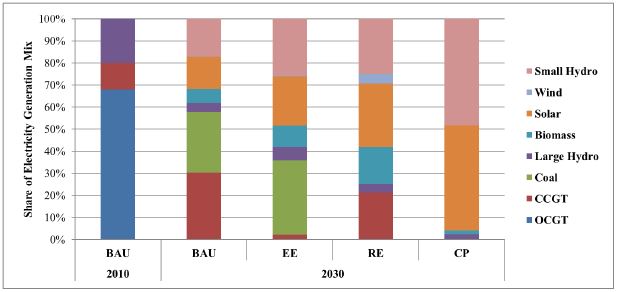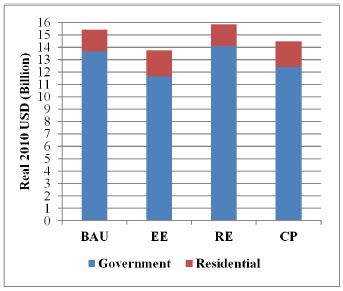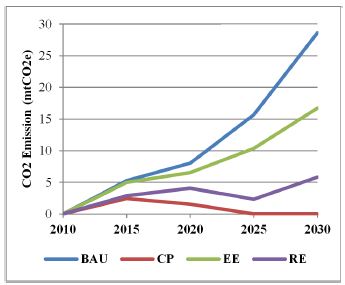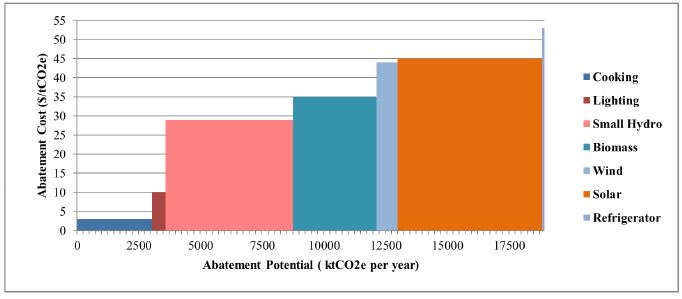
Analysis of Rural Electrification with Low Carbon Options in Nigeria
Copyright ⓒ2016 by the New & Renewable Energy
This is an Open Access article distributed under the terms of the Creative Commons Attribution Non-Commercial License (http://creativecommons.org/licenses/by-nc/3.0) which permits unrestricted non-commercial use, distribution, and reproduction in any medium, provided the original work is properly cited.
Abstract
The lack of access to electricity in rural Nigeria is a decades-old issue. This study provides a basis for rural electrification plans by projecting the plausible future supply and demand for electricity in the rural residential sector, using three alternate scenarios: EE; RE; and CP. Based on the projection, the feasible options are analyzed in terms of the total cost and CO2 emissions. The MAC curve was drawn to suggest policy priorities. Among these scenarios, the CP scenario is the most viable option in terms of both cost and CO2 emissions. This scenario saves USD 1.07 billion compared to the BAU, and has the lowest CO2 emissions among the scenarios. The MAC curve provides further insight in that the residential sector should purchase efficient cooking and lighting appliances, which requires USD 6.57 per tCO2e on average. On the supply side, the renewable energy technologies require USD 38.32 per tCO2e on average. Based on the findings, the policies balanced between CO2 reduction and social developments are suggested to the Federal Government of Nigeria.
Keywords:
Nigeria, Rural Electrification, Low Carbon, Renewable Energy, Energy Efficiency1. Introduction
The lack of access to electricity in Nigeria is a decades-old issue, with over 60% of the population lacking access to electricity. The situation in the rural areas are more severe, and the rural population relies heavily on traditional biomass to meet their basic energy needs. As the situation shows no sign of improvement, the rural population is forced to migrate to cities in a search for better life.
The Federal Government of Nigeria (FGN) attempted to tackle this lingering issue by issuing several national plans.[1] However, only a minor progress has been achieved, and a reason for this is that the plans only have broad objectives without any specific roadmaps.[2] Therefore, this study aims to project a plausible future supply and demand of electricity for the rural residential sector using the Long-range Energy Alter-native Planning System (LEAP) model. Then, based on the projection, feasible options for the FGN are analyzed based on the cost – electricity generation and acquisition of household appliance – and carbon dioxide (CO2) emissions. Afterwards, policy priorities for low carbon options are drawn from the marginal abatement cost (MAC) curve. Section 2 presents the literature review. Section 3 explains the LEAP model, and presents three scenarios used for analysis. Section 4 analyzes the results and present policy implications. Lastly, Section 5 concludes.
2. Literature Review
2.1 Nigeria National Plans
In 2003, the National Energy Policy (NEP) was issued to tackle the lingering issues in the energy sector, such as rural electrification, implementation of renewable energy, and energy efficiency.[3] In 2009, Nigeria Vision 20:2020 was developed by the National Planning Commission (NPC) as the main development goals to coordinate and harmonize the national efforts. For the energy sector, the plan is to increase the electricity generation to provide access to about 80% of the population by 2020.[4] Lastly, in 2015, the National Renewable Energy and Energy Efficiency Policy (NREEEP) was drafted to follow suit with the global efforts towards low carbon developments.[5]
2.2 Rural Electrification and Renewable Energy
Currently, Nigeria’s national energy mix heavily relies on selective number of resources, such as traditional biomass, oil and natural gas; thus, the previous researches in unison state that Nigeria should make a better use of its abundant resources, and pursue a more sustainable path.[6-7] In terms of specific technologies, solar, wind, biomass and small hydro are selected as feasible options.
Adaramola et al. examine the solar system options and concludes that solar PV, generator and battery hybrid system are suitable for decentralized systems.[8] Likewise, Ogunleye and Awogbemi examine the economic potential of solar PV system, and concluded that currently the solar system is too costly for an average household; thus, the government needs to provide financial support.[9]
Diyoke et al. explain that biomass gasification technology could be used to meet the rural energy needs.[10] Also, Jekayinfa and Scholz estimate that, in 2004, the agricultural residue produced was 20.81 million toe, which is approximately 82% of the annual energy consumption.[11]
Several scholars have performed wind mapping to examine the viability of wind technology in Nigeria. Overall, the technology faces many challenges due to low wind speed, but there is a possibility of imple-mentation in the North of Nigeria.[12]
Ohunakin et al. explains that the hydropower is already widely being used in Nigeria, therefore, the operating and maintenance (O&M) cost is generally low for small hydropower (SHP). However, without the support of the government, the implementation of the hydropower and renewable energy will be difficult.[13]
2.3 LEAP Model Application
In 1980, Stockholm Environmental Institute Boston (SEIB) created the LEAP model for the purpose of integrated energy planning.[14] By 2015, there are over 26,000 users in 190 countries, and LEAP model is one of the main reporting tool for United Nations Framework Convention on Climate Change (UNFCC). Furthermore, the model is also widely amongst govern-ment agencies, research institutes, academia, and various industries.[15] For example, Takase and Suzuki examined Japan’s current energy system and predicted the plausible paths based on varying degree of govern-ment policies, such as liberalization of energy market or evolution of nuclear policies.[16] Huang et al. con-ducted a research on long-term forecast of Taiwanese energy system and related CO2 emissions.[17] In Central America, McPherson and Karney examined four develop-ment paths for Panama’s electricity sector.[18]
3. Methodology
3.1 LEAP Model Structure
LEAP model is a tool for creating various energy systems, and also, supports various types of modeling methodologies. The structure of LEAP model, shown in Fig. 1, consists of six interacting programs, which can be operated individually or collectively.
There are two socio-economic programs, responsible for analyzing the demographic and macro-economic changes. Then, the three energy prediction programs for analyzing the energy demand, transformation, and available resources. The cost analysis program conducts integrated cost-benefit analysis by using the data of capital investment, O&M cost, fuel cost and others.[20]
3.2 Energy Consumption
The equation of total final energy consumption is as follows:
| (1) |
In equation 1, FEC is the final energy consumption in the rural residential sector, AL is the activity level, EI is the energy intensity, and i is the device.
The equation for energy consumption for transfor-mation is as follows:
| (2) |
In equation 2, ECT is the energy consumption for transformation, TP is the product of energy trans-formation, TE is the energy transformation efficiency, e is the equipment, p is the type of primary energy, and s is the secondary energy.
3.3 Carbon Emission
The equation of carbon emission from the total final energy consumption is as follows:
| (3) |
In equation 3, RCE is the carbon emission from the rural residential sector, AL is the activity level, EI is the energy intensity, and EF is the CO2 emission from device i.
The carbon emission from energy transformation is calculated as follows:
| (4) |
In equation 4, ECT is the energy consumption for transformation, TP is the product of energy trans-formation, TE is the energy transformation efficiency, and EF is the emission factor, which is the CO2 emission from one unit of primary fuel, p, consumed for producing secondary fuel, s, by using equipment, e.
3.4 Data
In this study, the LEAP model is used to examine the electricity demand and supply of the rural residential sector only. The analysis period is from 2010 to 2030 in order to align the study with the Nigerian national plans. Table 1 presents the data used in the LEAP model.
3.5 Scenarios
The scenarios represent plausible future pathways that FGN may pursue through national policies. The three scenarios used in this study are the Energy Efficiency (EE), the Renewable Energy (RE), and the Combined Policy (CP). Fig. 2 presents the energy demand projections of each scenario, rural residents of Nigeria.
The EE scenario is a pathway where the FGN focuses on improving energy efficiency of household appliances. The RE scenario is a pathway where the FGN will actively promote the electricity generation through the renewable technologies. The CP scenario is a pathway where the FGN decides to aggressively pursue low carbon options in both supply and demand side. These three pathways are designed by considering the key drivers – socio-economic change and tech-nological advancement – which will shape the future characteristics of the rural residential sector.
The Shared Socioeconomic Pathway (SSP) scenarios are used as a reference for the economic and demo-graphic projections. The SSP scenarios are designed by International Institute for Applied Systems Analysis (IIASA) based on the need for common scenarios among the research community studying the impacts of climate change, adaption, and mitigation.[30] This study employs the SSP 2 scenario for GDP projection, total population growth and the rate of urbanization.
The technological advancement refers to the level of adoption of low carbon technologies in Nigeria, which is largely dependent on the political will of the FGN. The government may focus on improving the energy efficiency of household appliances, or focus on supplying more electricity by building additional power plants. Fig. 3 presents the share of electricity generation mix for each scenario.
The Business-As-Usual (BAU) scenario is designed to project a plausible future path of Nigeria based on historical trends and current government actions. There will be a rapid expansion in generation capacity to meet the currently suppressed electricity demand, and further rapid growth in demand as the rural electrification target is achieved. In BAU scenario, the national target of 60% rural electrification[31] will be met, with the household using inefficient appliances. The FGN will continue to favor thermal power plants, but some investment will be made for research and development (R&D) of renewable tech-nology.[32] In this scenario, available technologies are open cycle gas turbine (OCGT), combined cycle gas turbine (CCGT), coal, hydropower, wind, biomass and solar PV.
Demand-side energy efficiency is important as it lowers the electricity demand, which in turn reduces the need for additional electricity generation. How-ever, this faces many challenges in raising consumer awareness and changing their behavior, especially in developing countries like Nigeria. In the rural areas, price of a commodity plays an important role in purchasing goods, and the consumers wants to minimize the initial cost as much as possible.[33] Therefore, there is a prevalent use of incandescent light bulbs and secondhand appliances because it is much cheaper compared to the substitute goods. In Energy Efficiency (EE) scenario, the FGN will actively pursue energy efficiency policies for household appli-ances. These government policies will create a synergy with the rise in income, and eventually the electrified rural households will use efficient appliances by 2030.
In Renewable Energy scenario, the FGN will actively support the market penetration of renewable tech-nologies, while maintaining the same rural electri-fication goal of BAU scenario. Plans for the use of coal are abolished, and instead the investment will be transferred to renewable technologies. Thus, the 20% of coal planned for the electricity mix will be replaced by the renewable technologies. In this scenario, the low carbon strategy will only be focused on the supply side and no plans exist to purse energy effi-ciency in the demand side.
The Combined Policy (CP) scenario shows the future path of rural areas when the FGN decides to aggressively pursue low carbon strategies in both supply and demand side. In this scenario, the rural electrification goal of 60% will be achieved, while the old appliances will be replaced with energy efficient appliances by 2030. Also, the FGN will push for market penetration of renewable energy technologies, while plans for coal power plants are abolished. Table 2 presents the comparison between scenarios.
4. Results
4.1 Cost of Rural Electrification
The total cost of a project is one of the key indicators for deciding the viability of the project. In developing countries, like Nigeria, many projects are planned but fail to be implemented due to lack of budget. Rural electrification is a massive project that the FGN has long been struggling to achieve and the major obstacle is the budget to carry out the plans. Rural electrification cannot be done solely by the government alone but the residents needs to also bear some cost. Therefore, as shown in Fig. 4, the total cost of rural electrification calculated sepa-rately for the residential sector and the government.
In BAU scenario, the government bears the cost of USD 13.64 billion, while the residential sector bears USD 1.77 billion over 20 years. In EE scenario, the overall cost is the lowest, but the cost is trans-ferred to the residential sector. Thus, the residential sector bears additional USD 300 million, while the government reduces the cost by USD 1.97 billion. This is a promising scenario for solving the energy poverty issue in Nigeria as the overall project cost is low, and the FGN could support the residential sector with the saved cost. Then, RE scenario has the highest overall cost of USD 15.86 billion. The residential sector shows no difference in cost with BAU scenario. However, as the renewable energy technologies have high initial cost, the government has to bear additional USD 454 million over the course of the project. Lastly, CP scenario has the second lowest overall cost of USD 14.46 billion. As the efficiency of household appliances increase, less electricity is required, and this reduces the burden of electricity generation. Therefore, in terms of cost alone, the EE scenario is the most promising pathway for rural electrification. However, as the FGN has a strong desire for low carbon development, CO2 emission of each scenario is discussed in the following section.
4.2 CO2 Emission
CO2 emission reduction potential varies greatly based on which technology and low carbon policies are implemented in each scenario. The overall CO2 emission from electricity generation of each scenario is compared in Fig. 5.
BAU scenario shows the total emission of 28.6 million metric ton of CO2 equivalent (mtCO2e) in the target year, as there are no strong policy inter-ventions to drive the low carbon development. The energy efficiency programs and policies alone in EE scenario manages to reduce the CO2 emission by 41.5% compared to BAU scenario. Then, RE scenario reduces additional 38% from EE scenario as electricity is mostly generated by renewable resource. In CP scenario, there is no CO2 emission by 2025, which is the combined effect of using energy efficient appli-ances and renewable energy for electricity generation. By 2030, as all electrified rural household have obtained efficient household appliances, there is the overall electricity demand is greatly reduced. Accordingly, electricity generation with renewable energy became more cost effective rather than pro-ducing excess electricity from large power plants. Therefore, CP scenario has great potential in terms of both cost and CO2 emission.
4.3 MAC Curve
MAC curves are widely used by policy makers and have become a standard policy tool for assessing the economics of climate change mitigation options. It is a useful tool that could present complex issues of cost-effective emissions reduction simply, and also can pinpoint the responsible technology for the reduction of CO2 emission.[34] The MAC can be easily calculated using equation 5:
| (5) |
The MAC is defined at time t for technology j, which is a substitute technology to i. Ei,t is the CO2 emission of technology i in BAU scenario, and Ej,t is the CO2 emission of the substitute technology j in low carbon scenario. Ci,t is the net present value (NPV) of technology i, associated with Ei,t, and Cj,t is the NPV of technology j, associated with Ej,t. Afterwards, MAC data for each low carbon measures (y-axis) with associated CO2 reduction potential (x-axis) are ordered from lowest to highest marginal abatement cost, to complete the MAC curve. Fig. 6 presents the MAC curve of the target year 2030 and the technologies with mitigation potentials.
If FGN wishes to seize the full mitigation potential in the process of rural electrification, the government bears USD 38.32 per tCO2e on average, while the residential sector bears USD 22.05 per tCO2e on average, which is expensive for the rural population. Approximate 66% of rural population lives below USD 1.25 per day;[35] therefore, even considering the economic growth, it is not affordable. For the residential sector, it would be more reasonable to focus on cooking and lighting household appliances only. These technologies require USD 6.57 per tCO2e on average, which is affordable with government subsidies. Then the competitive renewable technologies – solar, hydro and biomass – can be implemented with USD 36.31 per tCO2e on average. Therefore, the government can prioritize the policies by focusing on the implementation of renewable technologies, then subsidizing the basic household appliances of cooking and lighting, which consumes the most electricity.
4.4 Policy Implication
The results drawn from the alternative scenarios provide some policy implications for achieving rural electrification with low carbon options in Nigeria. First, energy efficiency can be achieved in both demand and supply side through improved technologies.
On the demand side, by achieving energy efficiency, the necessity to generate extra electricity will be reduced greatly as seen in EE scenario. As the rural populations buy inefficient household appliances to lower initial cost, it is necessary to educate the populace on energy use and benefits of energy efficiency. Then, FGN should control the proliferation of inefficient household appliances. As most appliances are imported into Nigeria, applying higher tariff on these products can be a remedy. Also, appropriate efficiency standard should be set by the Standard Organization of Nigeria so that below the standard goods can removed from the market.
On the supply side, improving the efficiency of transmission lines and power plants can reduce the electricity loss. Energy Sector Management Assistance Program (ESMAP) reported that Nigeria not only faces poor electricity generation capacity, but have appalling infrastructure that fails to deliver the generated electricity.[36] Also, as the FGN plans to maintain the thermal power plants, the efficiency of these power plants should be improved. In this case, the CCGT can replace the OCGT for the higher efficiency and cost effectiveness.
Second, FGN should actively support the research and development (R&D) of renewable energy tech-nologies through public investments. The renewable energy technology industry is at its infancy, facing great challenges in supplying skilled human resources, and research funding; thus without the necessary public investments, the industry will remain stagnant. However, in 2007, Nigeria’s R&D allocation is USD 0.582 billion (PPP), which is approximately 0.2% of the national GDP.[37] Recently, FGN has drafted the National Research and Innovation Fund (NRIF) bill, but there are still several obstacles on the way of the bill being passed as a law. Therefore, FGN should devise national R&D strategy to plan, manage and fund the necessary sectors.
Lastly, the FGN should create a long-term strategy to promote investments towards into the renewable energy technologies. Several regulatory policies – feed-in-tariff (FIT), and renewable portfolio standards (RPS) – and fiscal incentives – capital subsidies, and production tax credits – are being used in the leading countries to promote renewable energy technologies.[38] FGN should also pursue these incentives and modify them to suit the Nigerian business conditions. Fur-thermore, as industrial development is a long-term process, the government should persistently support the industry until tangible results can be seen.
5. Conclusion
This study projected the possible future supply and demand of electricity for the rural residential sector. Based on the projection, feasible options for the FGN to match the supply and demand are analyzed based on the total cost and CO2 emissions. Afterwards, policy priorities for low carbon options are drawn from the marginal abatement cost (MAC) curve.
Three alternate scenarios – EE, RE, and CP – are used to determine plausible options for the rural electrification in Nigeria. Among these scenarios, EE scenario had the lowest total cost as the energy efficient appliances reduces the electricity demand significantly, but the residential burden is higher than BAU scenario. On the other hand, RE scenario has the second highest potential for reduction of CO2 emission but in this case, the government has to bear additional USD 454 million. Lastly, CP scenario is the most viable option in terms of both cost and CO2 emission. This scenario saves USD 1.07 billion compare to BAU scenario and reaches zero emission from electricity generation by 2025. The only issue is that the residential burden increase, which the government can assist with saved cost. Furthermore, the MAC curve has provided some insights on feasible policy options that can be prioritized by the FGN as it is cost ineffective to adopt all low carbon options.
So far, Nigeria is suffering from poor management of the electricity sector and this has been suppressing the growth potential; however, once this constraint is removed, Nigeria will experience an explosive growth like China. Rural electrification is the first and the most important step towards this future.
Acknowledgments
The authors appreciate Professor Chan Park, department of landscape architecture in University of Seoul for his valuable comments.
References
- Federal Government of Nigeria (FGN), (2010), “Report of the Vision 20: 2020 National Technical Working Group On Energy Sector”, http://www.npc.gov.ng.
- Independent Energy Watch, (2014), “Rural Electrification Agency (REA)”, http://iwin.org.ng/index.php/2014-10-11-16-33-00/rural-electrification-agency-rea.
- Energy Commission of Nigeria (ECN), (2014), “National Energy Policy”, http://www.energy.gov.ng.
- Energy Commission of Nigeria (ECN), (2014), “Draft National Renewable Energy and Energy Efficiency Policy”, http://www.energy.gov.ng.
-
Oyedepo, S. O, (2012), “On energy for sustainable development in Nigeria”, Renewable and Sustainable Energy Reviews, 16(5), p2583-2598.
[https://doi.org/10.1016/j.rser.2012.02.010]

-
Shaaban, M., Petinrin, J. O., (2014), “Renewable energy potentials in Nigeria: meeting rural energy needs”, Renewable and Sustainable Energy Reviews, 29, p72-84.
[https://doi.org/10.1016/j.rser.2013.08.078]

-
Adaramola, M. S., Paul, S. S., Oyewola, O. M., (2014), “Assessment of decentralized hybrid PV solar-diesel power system for applications in Northern part of Nigeria”, Energy for Sustainable Development, 19, p72-82.
[https://doi.org/10.1016/j.esd.2013.12.007]

- Ogunleye, I. O., Awogbemi, O, (2010), “Constraints to the use of solar photovoltaic as a sustainable power source in Nigeria”, American Journal of Scientific and Industrial Research, 2(1), p11-16.
- Diyoke, C., Idogwu, S., Ngwaka, U. C., (2014), “An economic assessment of biomass gasification for rural electrification in Nigeria”, International Journal of Renewable Energy Technology Research, 3(1), p1-17.
-
Jekayinfa, S. O., Scholz, V., (2009), “Potential availability of energetically usable crop residues in Nigeria”, Energy Sources Part A, 31(8), p687-697.
[https://doi.org/10.1080/15567030701750549]

-
Adaramola, M. S., Oyewola, O. M., (2011), “On wind speed pattern and energy potential in Nigeria”, Energy Policy, 39(5), p2501-2506.
[https://doi.org/10.1016/j.enpol.2011.02.016]

-
Ohunakin, O. S., Ojolo, S. J., Ajayi, O. O., (2011), “Small hydropower (SHP) development in Nigeria: an assessment”, Renewable and Sustainable Energy Reviews, 15(4), p2006-2013.
[https://doi.org/10.1016/j.rser.2011.01.003]

- SEI, (2015), “A short history of LEAP”, http://www.energycommunity.org/WebHelpPro/LEAP.htm.
-
Takase, K., Suzuki, T., (2011), “The Japanese energy sector: current situation, and future paths”, Energy Policy, 39(11), p6731-6744.
[https://doi.org/10.1016/j.enpol.2010.01.036]

-
Huang, Y., Bor, Y. J., Peng, C. Y., (2011), “The long-term forecast of Taiwan’s energy supply and demand: LEAP model application”, Energy policy, 39(11), p6790-6803.
[https://doi.org/10.1016/j.enpol.2010.10.023]

-
McPherson, M., Karney, B., (2014), “Long-term scenario alternatives and their implications: LEAP model application of Panama’s electricity sector”, Energy Policy, 68, p146-157.
[https://doi.org/10.1016/j.enpol.2014.01.028]

- SEI, (2015), “LEAP Structure”, http://www.energycommunity.org/WebHelpPro/LEAP.htm.
- Nigeria Statistical Data Portal, (2015), http://nigeria.prognoz.com/en/Map?G7YvTnd9iE6EB6hjXNNeBA.
- The World Bank Development Indicators, (2015), www.worldbank.org.
- IIASA, (2015), “SSP Database”, https://tntcat.iiasa.ac.at/SspDb.
- UNDP, (2013), “End-use Metering Campaign for Residential Houses in Nigeria (Draft)”, http://www.ng.undp.org/content/nigeria/en/home/library/environment_energy/end-use-metering-campaign-for-residential-houses-innigeria.html.
- Community Research and Development Centre, (2009), “Energy efficiency survey in Nigeria: a guide for developing policy and legislation”, http://www.credcentre.org/Publications/EE%20Survey%20Nigeria.pdf.
- Cervigni, R., Rogers, J.A., Dvorak, I., (2013), “Assessing low-carbon development in Nigeria : an analysis of four sectors”, http://documents.worldbank.org/curated/en/2013/01/17977719/assessing-low-carbon-developmentnigeria-analysis-four-sectors.
- Baek, Y.J., (2016), Analysis of Decentralized Low Carbon Energy System for Rural Households in Nigeria, Master’s Thesis, Yonsei University, Seoul.
-
O’Neill, B. C., Kriegler, E., Riahi, K., Ebi, K. L., Hallegatte, S., Carter, T. R., Mathur, R., van Vuuren, D. P., (2014), “A new scenario framework for climate change research: the concept of shared socioeconomic pathways”, Climatic Change, 122(3), p374.
[https://doi.org/10.1007/s10584-013-0905-2]

- GIZ, (2014), “The Nigerian energy sector- an overview with a special emphasis on renewable energy, energy efficiency and rural electrification”, https://www.giz.de/en/downloads/giz2014-en-nigerian-energy-sector.pdf.
-
Kesicki, F., Strachan, N., (2011), “Marginal abatement cost (MAC) curves: confronting theory and practice”, Environmental Science & Policy, 14(8), p1195-1204.
[https://doi.org/10.1016/j.envsci.2011.08.004]

- National Bureau of Statistics, (2010), “Nigeria Poverty Profile 2010”, http://www.nigerianstat.gov.ng/pdfuploads/Nigeria%20Poverty%20Profile%202010.pdf.
- World Bank, (2005), “Nigeria: expanding access to rural infrastructure issues and options for rural electrification, water supply and telecommunications”, http://documents.worldbank.org/curated/en/2005/12/6757356/nigeriaexpanding-access-rural-infrastructure-issues-optionsrural-electrification-water-supply-telecommunications.
- Akinwale, Y., Ogundari, I., Olaopa, O., Siyanbola, W., (2012), “Global best practices for R&D funding: Lessons for Nigeria”, Interdisciplinary Journal of Contemporary Research in Business, 4(2), p908-925.
- KPMG, (2015), “Taxes and incentives for renewable energy”, https://assets.kpmg.com/content/dam/kpmg/pdf/2015/09/taxes-and-incentives-2015-web-v2.pdf.
